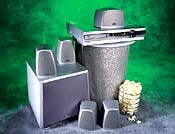Instant Home Theater Page 3
Although the fluorescent display is readable enough, the onscreen displays that the receiver/player generates on your TV are more stylish. The remote control is unusually attractive, with styling that matches the receiver and glow-in-the-dark keys. It's also preprogrammed to control most TVs. While the remote's printed legends are small and a bit hard to read, the handset is still fairly easy to use thanks to its logical layout and use of different key sizes.
It was a straightforward process to set up the Sony DAV-C900 system and adjust its speaker levels and time delays. The receiver has only a single optical digital audio input and output (no coaxial), only a single VCR input, and no provision for any other analog component.
When I took the system to the apocalyptic war, it survived with honor. The modest subwoofer delivers more than a pretty face. The whoomp of the chopper blades and the boom of the bombs shook the house to such a degree that I expected a visit from my new neighbors. The guns sharply reported. Every obscenity came through loud and clear, as did the whispered dialogue. My only mild disappointment was a lack of musical warmth and depth in The Ride of the Valkyries accompanying the helicopter-attack scene. I remember a more all-encompassing musical wash in the theater. Legendary Doors frontman Jim Morrison, however, sounded his normal agonized self, with the system reproducing the full fabric of his deep, rugged voice.
The DAV-C900 was equally adept at peace. The Telarc CD of the Brahms Second Piano Concerto, with Horacio Gutierrez as soloist and André Previn conducting, sounded full, authoritative, and balanced. To check the pop side of the spectrum, I played a CD released not too long after the original version of Apocalypse Now, Dire Straits's Making Movies. Mark Knopfler and the gang sounded just right, with full instrumentals, an appropriately twangy Fender guitar, and clean vocals. I pushed the Sony Dream System's limits and found that its maximum volume was limited, as I would expect. But like the other systems in this group, the DAV-C900 is meant for small to moderate-size rooms. Sony succeeded in designing a system that can surround you with full 5.1-channel sound while taking up little more space than a conventional two-channel system. It goes a long way to counter typical objections to home theater.
 Kenwood/Boston Acoustics Unity Kenwood teamed up with the highly regarded speaker maker Boston Acoustics to create the Unity system. It seems an intelligent move for Kenwood - leave the speakers to the experts. The oddly shaped, gray plastic satellite speakers, with 3-inch midrange drivers and 3/4-inch tweeters, look something like multimedia computer speakers. The center speaker is about the size of a small loaf of bread, the left/right front and surround satellites slightly smaller. The subtly trapezoidal subwoofer, which packs an 8-inch driver and a 100-watt amp, is roughly the size of a 12-inch cube. The full-size Kenwood receiver, which incorporates a single-disc DVD/CD player, supplies 30 watts to each of the satellites.
Kenwood/Boston Acoustics Unity Kenwood teamed up with the highly regarded speaker maker Boston Acoustics to create the Unity system. It seems an intelligent move for Kenwood - leave the speakers to the experts. The oddly shaped, gray plastic satellite speakers, with 3-inch midrange drivers and 3/4-inch tweeters, look something like multimedia computer speakers. The center speaker is about the size of a small loaf of bread, the left/right front and surround satellites slightly smaller. The subtly trapezoidal subwoofer, which packs an 8-inch driver and a 100-watt amp, is roughly the size of a 12-inch cube. The full-size Kenwood receiver, which incorporates a single-disc DVD/CD player, supplies 30 watts to each of the satellites.
The Unity resembles the Sony system in some ways. It also comes with a full-color setup poster and an informative 58-page manual. And it's about as easy to set up, using color-coded wires with connectors that snap into the player/receiver and color-coded ends that fit into snap connectors on the speakers. The subwoofer connects via a special three-conductor cable and must be plugged into its own AC outlet. The left/right satellites lack stands but have keyholes for wall mounting.
Kenwood's DVD player can handle both recordable CD-Rs and rewritable CD-RWs containing MP3 files. The minimal controls blend into a front-panel trim stripe, keeping the design sleek and sexy. Multicolor LEDs on the lower half of the panel indicate the decoding/ processing system in use, except there is none for stereo mode. An unusually bright red LED shines down on and reflects off the large, rectangular power button on the lower left side. A fluorescent dot-matrix display fills the center, while a large, very shiny silver volume knob sits just to its right. A spare set of inputs along with radio tuning controls hide behind a fold-down door on the lower right.

























































